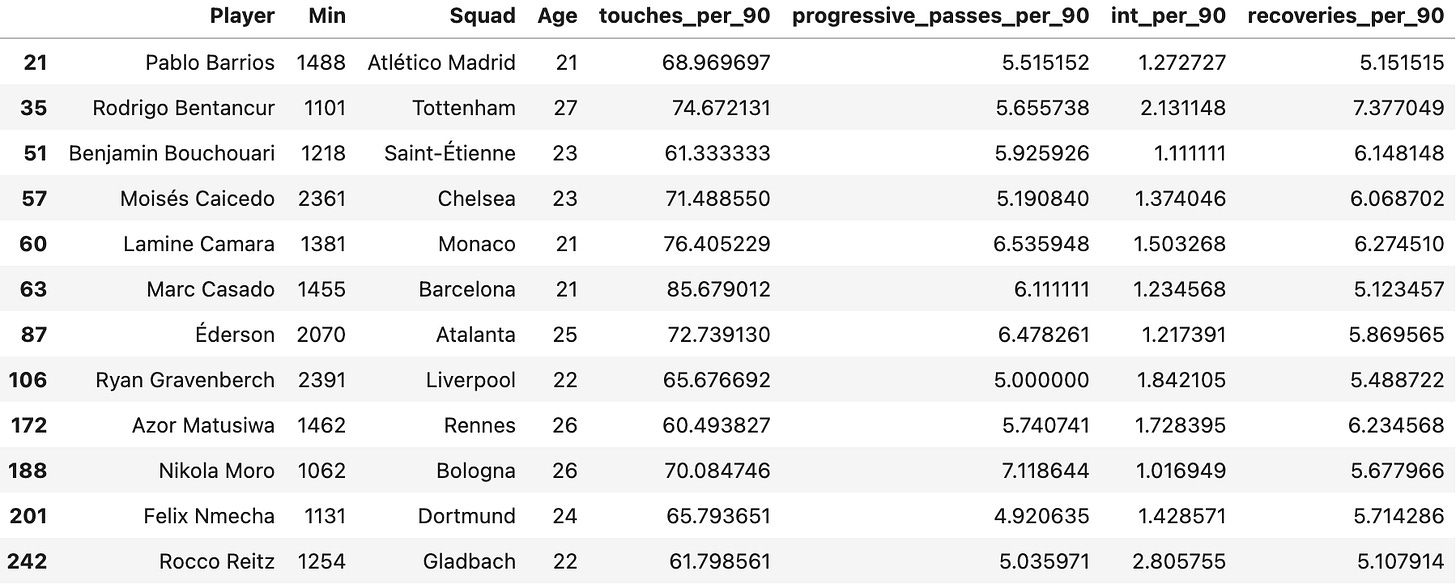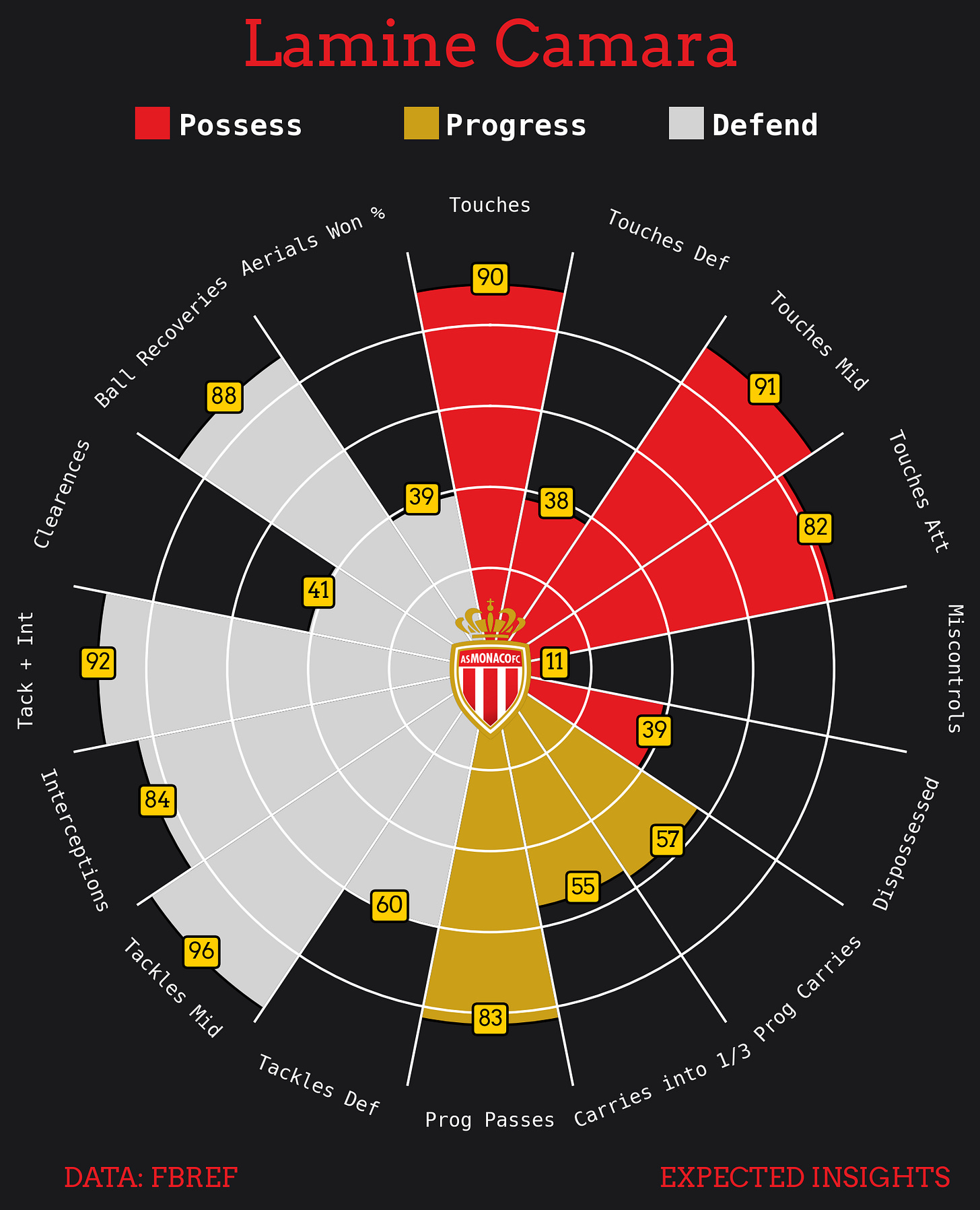Data Scouting for Elite Midfielders in Europe
Striking the Ideal Balance between a Progressor and a Disruptor
This is my second article here on Substack where I try to search for a specific role or player profile based on data.
In my first article on this theme, I discovered ball playing defenders in Europe’s top 5 leagues. Today, I will scout for the deep-lying playmaker, perhaps now known as the ‘Rodri’ role that Manchester City have sorely missed this season.
Scouting players through data is an exciting challenge, as it begins with a vast pool of talent that gets refined and narrowed down based on specific criteria. To streamline this process, I’ve developed my own structured approach to data scouting which I call “The Data Scout Method”. You can read about this in my first article below.
Profile - The Deep Lying Playmaker
The deep-lying playmaker, in my view, is one of the most crucial positions on the pitch. This player should be technically proficient, able to link defense with attack, and contribute defensively when possession is lost.
Players in this role require a well-rounded skill set, although many teams opt for a double pivot, where the two players share responsibility for both progressing the ball and defending, effectively acting as a shield for the backline.
Teams like Liverpool and Manchester City have long used a single pivot, which demands even more from the player in that role. Currently, both teams utilize a double pivot, but in past years, they’ve relied on a single pivot.
For instance, Fabinho in Liverpool's midfield exemplified the ‘destroyer’ role, while Rodri at City has set the standard for a defensive midfielder who excels on the ball and controlling the tempo while being highly effective in defensive transitions.
Regardless of whether a team plays with a single or double pivot, the role’s demands mean the player must be exceptional both in and out of possession.
Criteria
This brings me to the data criteria for this role. First, I’m looking for a midfielder who is comfortable on the ball and trusted by his teammates in build-up play. To measure this, I’ll use the number of touches as an indicator.
Another key aspect is progressive passes—because I want my midfielder to do more than just play sideways or backwards. He must be capable of advancing the ball up the pitch. These are the key offensive, in-possession metrics I’ll focus on.
For the defensive metrics, I’ll use interceptions and ball recoveries to assess how effectively the player handles defensive transitions and meets the physical demands of the game.
In essence, I want my deep-lying playmaker to be both a progressor and a disruptor.
Metrics
Here’s a summary of the key metrics I’ll use for this data search:
Position = MF
Age ≤ 27 years
Minutes Played ≥ 900 (10 Games)
Touches p90 ≥ Above Average
Progressive Passes p90: Above Average
Interceptions p90: Above Average
Recoveries p90: Above Average
Note that I haven’t set specific thresholds for the main metrics. Instead, I’ve calculated the mean values for each metric and applied a filter where the midfielders need to score at or above average across all chosen metrics.
Filter
In my first article, I went into more detail about how the player pool gradually shrank as I applied each filter. Today, I’m using a more streamlined approach. I started by filtering for midfielders under the age of 27 in the top 5 European leagues, which resulted in a list of 258 players.
In the next phase, I applied the remaining filters, which brought the list down to just 12 potential players. Here are the results, in no particular order:
A couple of players I expected to make this list are Moisés Caicedo and Ryan Gravenberch. Both are exceptionally well-rounded, capable of progressing and disrupting play.
Gravenberch, in particular, has been a revelation for Liverpool this season, operating in a dynamic double pivot with Mac Allister, but mainly functioning as the single pivot. He’s become the player Liverpool’s defenders look to feed the ball through.
His impact has been so significant that opponents have started man-marking him or cutting off passing lanes into him during build-up play (this happened against Everton for example).
In Possession
Another exciting player on the list is Éderson from Atalanta. His stats show that he outperforms both Gravenberch and Caicedo in terms of progression, averaging 6.4 progressive passes per 90 minutes.
Other notable players include Nikola Moro from Bologna, who averages 70 touches per game and 7.1 progressive passes. Lamine Camara of Monaco, at just 21 years old, averages 76.4 touches per 90 minutes and 6.5 progressive passes per 90 minutes.
Lastly, Marc Casado from Barcelona deserves a mention, ranking highest for touches per 90 minutes. He’s been receiving well-deserved praise, alongside the young talent that Barcelona continues to develop.
Out Of Possession
For the defensive metrics, I’ll visualize them in a scatter plot. Here, we’ll focus on interceptions per 90 minutes and ball recoveries per 90 minutes.
From the scatter plot, two players clearly stand out. The first is Rocco Reitz from Borussia Mönchengladbach, who averages 2.8 interceptions per 90 minutes—the highest in Europe. He’s definitely a player to keep an eye on, especially considering he’s just 22 years old. For ball recoveries per 90 minutes, Rodrigo Bentancur surprises by ranking highest, averaging 7.3 recoveries per 90.
Both Gravenberch and Caicedo—our ideal player profiles—also make an appearance, which serves as a nice confirmation that the data aligns with what we see with our eyes when watching the Premier League.
However, the most intriguing player in this dataset is Lamine Camara. He’s shown impressive numbers both offensively and defensively. Playing for a young and exciting Monaco side, he ranks highly for touches and excels in both progression and disruption metrics.
Visualize
We’ve found our ideal deep-lying playmaker in Lamine Camara. To dive deeper into his stats, let's look at the radar chart, which compares him to all 258 midfielders under 27 years old in the top 5 leagues.
First, we can see that Camara ranks in the 90th percentile for touches, with the majority of them occurring in midfield. This suggests that he’s very press-resistant, a trait that is further supported by his low scores for miscontrols and dispossessions (11th and 39th percentile). These statistics are inversed, so lower percentile scores are actually a positive indicator.
When we turn our attention to his progressive stats, Camara ranks in the 83rd percentile for progressive passes, which is impressive but not unexpected given his style of play.
However, it’s his defensive stats that truly stand out. He ranks in the 96th percentile for tackles in the middle third, meaning he’s extremely active and effective in defensive transitions, handling the physical demands of the game with ease. On top of that, he scores in the 92nd percentile for tackles + interceptions and the 88th percentile for ball recoveries.
In short, Camara is an incredibly well-rounded midfielder who excels in both progression and disruption—exactly what we were looking for in the role.
Compare
For comparison, let’s also take a look at Ryan Gravenberch, arguably the best player in this role in Europe this season.
They are actually quite different profiles, and we must remember that these differences often reflect varying styles of play.
The most significant distinction in possession is that Gravenberch excels in progressive carries and carrying the ball into the final third. This has become somewhat of his trademark this season—he expertly uses his body to receive under tight pressure and then drives forward with the ball at pace.
In addition to his progression with the ball, Gravenberch ranks in the 95th percentile for interceptions, highlighting his ability to read the game and intercept passes with precision. What’s also noteworthy is his ranking in the 98th percentile for aerial duels won, as he rarely loses a duel in the air.
So, while Camara and Gravenberch share some similarities, their skillsets cater to different roles within their respective teams and systems, with Gravenberch standing out as more of a dynamic ball carrier and a master at intercepting and winning aerial battles.
Conclusion
We began our data search for what I referred to as ‘Deep-lying Playmakers’, and our final pick based on both offensive and defensive metrics is Lamine Camara.
While deep-lying playmakers have traditionally been viewed as smooth, silky single pivots, I wanted to focus on a profile that excels across multiple areas. Camara is not a typical #6, but rather a player who stands out in both attacking and defending, and we could likely categorize him as a hybrid 6/8.
So, while we haven’t found the ideal 'Rodri-replacement' in terms of a pure, ball-controlling deep-lying playmaker, we've identified a more physical profile in Lamine Camara. His skill set goes beyond just moving the ball and controlling the tempo; he takes on more responsibility, excelling both in defensive transitions and progression.
From watching his play, it’s clear that he is highly aggressive off the ball. He’s also able to receive and drive forward with the ball into the opposition’s third, showcasing his versatility. On top of that, he’s contributing to goals and assists, having netted 2 goals and registered 6 assists so far this season in Ligue 1.
Camara could easily thrive in a more offensive role in a double pivot, thanks to his ability to cover large distances, but I could also see him playing as a #8 in a midfield three. In a team like Manchester United, he could fit well in the demanding two-man midfield role.
All in all, he’s an incredibly exciting player who could very well make a move to a bigger club in the near future.
📧 If you enjoyed this post, I’d appreciate it if you would share it with a friend 🌟
🔗 I post regularly on my LinkedIn as well, so feel free to connect with me there 🤝
References:
The Independent (2025). Unexpected reinvention puts Ryan Gravenberch at the centre of Arne Slot’s Liverpool evolution. URL: https://www.independent.co.uk/sport/football/ryan-gravenberch-liverpool-arne-slot-ipswich-b2598038.html
Data sourced from FBref (2025).









